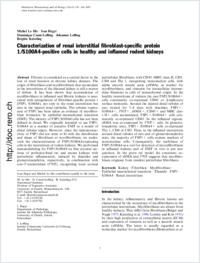Characterization of renal interstitial fibroblast-specific protein 1/S100A4-positive cells in healthy and inflamed rodent kidneys
- Le Hir, Michel Anatomical Institute, Division of Vegetative Anatomy, University of Zurich, Switzerland
- Hegyi, Ivan Department of Pathology, Institut für Klinische Pathologie, University of Zürich, Switzerland
- Cueni-Loffing, Dominique Anatomical Institute, Division of Vegetative Anatomy, University of Zurich, Switzerland
- Loffing, Johannes Anatomy Unit, Medicine Department, University of Fribourg, Switzerland
- Kaissling, Brigitte Anatomical Institute, Division of Vegetative Anatomy, University of Zurich, Switzerland
-
15.06.2005
Published in:
- Histochemistry and Cell Biology. - 2005, vol. 123, no. 4-5, p. 335-346
kidney
fibroblast
myofibroblast
epithelial mesenchymal transition
thiazide
FSP1
S100A4
renal interstitium
English
Fibrosis is considered as a central factor in the loss of renal function in chronic kidney diseases. The origin of fibroblasts and myofibroblasts that accumulate in the interstitium of the diseased kidney is still a matter of debate. It has been shown that accumulation of myofibroblasts in inflamed and fibrotic kidneys is associated with upregulation of fibroblast-specific protein 1 (FSP1, S100A4), not only in the renal interstitium but also in the injured renal epithelia. The tubular expression of FSP1 has been taken as evidence of myofibroblast formation by epithelial–mesenchymal transition (EMT). The identity of FSP1/S100A4 cells has not been defined in detail. We originally intended to use FSP1/S100A4 as a marker of putative EMT in a model of distal tubular injury. However, since the immunoreactivity of FSP1 did not seem to fit with the distribution and shape of fibroblasts or myofibroblasts, we undertook the characterization of FSP1/S100A4-expressing cells in the interstitium of rodent kidneys. We performed immunolabeling for FSP1/S100A4 on thin cryostat sections of perfusion-fixed rat and mouse kidneys with peritubular inflammation, induced by thiazides and glomerulonephritis, respectively, in combination with ecto-5’-nucleotidase (5’NT), recognizing local cortical peritubular fibroblasts, with CD45, MHC class II, CD3, CD4 and Thy 1, recognizing mononuclear cells, with alpha smooth muscle actin (αSMA), as marker for myofibroblasts, and vimentin for intracellular intermediate filaments in cells of mesenchymal origin. In the healthy interstitium of rodents the rare FSP1/S100A4+ cells consistently co-expressed CD45 or lymphocyte surface molecules. Around the injured distal tubules of rats treated for 3–4 days with thiazides, FSP1+/S100A4+, 5’NT+, αSMA+, CD45+ and MHC class II+ cells accumulated. FSP1+/S100A4+ cells consistently co-expressed CD45. In the inflamed regions, αSMA was co-expressed by 5’NT+ cells. In glomerulonephritic mice, FSP1+/S100A4+ cells co-expressed Thy 1, CD4 or CD3. Thus, in the inflamed interstitium around distal tubules of rats and of glomerulonephritic mice, the majority of FSP1+ cells express markers of mononuclear cells. Consequently, the usefulness of FSP1/S100A4 as a tool for detection of (myo)fibroblasts in inflamed kidneys and of EMT in vivo is put into question. In the given rat model the consistent co-expression of αSMA and 5’NT suggests that myofibroblasts originate from resident peritubular fibroblasts.
- Faculty
- Faculté des sciences et de médecine
- Department
- Département de Médecine
- Language
-
- English
- Classification
- Biological sciences
- License
-
License undefined
- Identifiers
-
- RERO DOC 5139
- DOI 10.1007/s00418-005-0788-z
- Persistent URL
- https://folia.unifr.ch/unifr/documents/299898
Statistics
Document views: 171
File downloads:
- Texte intégral: 265
